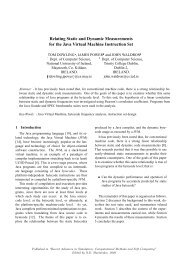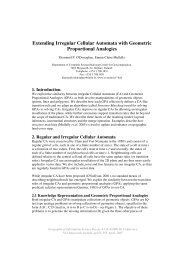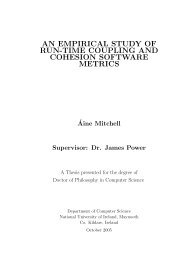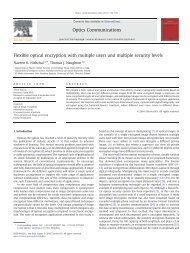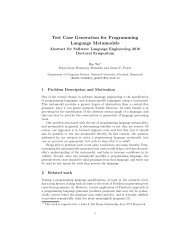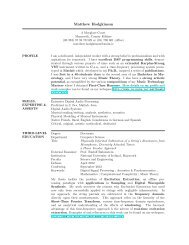Lesson 4: Formatting Paragraphs and Working with Styles
Lesson 4: Formatting Paragraphs and Working with Styles
Lesson 4: Formatting Paragraphs and Working with Styles
You also want an ePaper? Increase the reach of your titles
YUMPU automatically turns print PDFs into web optimized ePapers that Google loves.
<strong>Lesson</strong> 4: <strong>Formatting</strong> <strong>Paragraphs</strong> <strong>and</strong> <strong>Working</strong> <strong>with</strong> <strong>Styles</strong>When you type information into Word, each time you press the Enter key Word creates a newparagraph. You can format paragraphs. For example, you can indent the first line of a paragraph,you can set the amount of space that separates paragraphs, <strong>and</strong> you can align a paragraph left, right,center, or flush <strong>with</strong> both margins. <strong>Styles</strong> are a set of formats you can quickly apply to a paragraph.For example, by applying a style, you can set the font, set the font size, <strong>and</strong> align a paragraph all atonce. In this lesson, you will learn about the various formats you can apply to a paragraph <strong>and</strong>about styles.When you are formatting a paragraph, you do not need to select the entire paragraph. Placing thecursor anywhere in the paragraph enables you to format it. After you format a paragraph, pressingthe Enter key creates a new paragraph in the same format.Open a Blank DocumentTo begin a new Word project, you start by opening a new document.To begin this lesson, open ablank document in Microsoft Word.EXERCISE 1Open a Blank Document1. Open Word 2007.2. Click the Microsoft Office button. A menu appears.3. Click New. The New Document dialog box appears.
4. Click Blank Document.5. Click Create. A new blank document opens.Add Sample TextThis lesson uses sample text provided by Microsoft for training <strong>and</strong> demonstration purposes. Youcan type the text; however, there is a quicker way. You can use the r<strong>and</strong> function.Functions are used to obtain information. You tell the function what you want <strong>and</strong> the functionreturns that information to you. By default, in Word, when you type the r<strong>and</strong> function, Word returnsthree paragraphs. When working <strong>with</strong> functions, you use arguments to be specific about what youwant the function to return. There are two arguments you can use <strong>with</strong> the r<strong>and</strong> function. The firstone tells Word how many paragraphs you want, <strong>and</strong> the second one tells Word how many sentencesyou want in a paragraph. You place arguments between the parentheses <strong>and</strong> you separate them <strong>with</strong>a comma. For example, if you type =r<strong>and</strong>() <strong>and</strong> then press Enter, word returns three paragraphs. Totell Word you want two paragraphs <strong>with</strong> three sentences in each paragraph, you type =r<strong>and</strong>(2,3).EXERCISE 2Add Sample Text1. Type =r<strong>and</strong>().2. Press the Enter key. The following text appears:On the Insert tab, the galleries include items that are designed to coordinate <strong>with</strong>the overall look of your document. You can use these galleries to insert tables,headers, footers, lists, cover pages, <strong>and</strong> other document building blocks. When youcreate pictures, charts, or diagrams, they also coordinate <strong>with</strong> your currentdocument look. You can easily change the formatting of selected text in the document text bychoosing a look for the selected text from the Quick <strong>Styles</strong> gallery on the Home tab.
You can also format text directly by using the other controls on the Home tab.Most controls offer a choice of using the look from the current theme or using aformat that you specify directly. To change the overall look of your document, choose new Theme elements on thePage Layout tab. To change the looks available in the Quick Style gallery, use theChange Current Quick Style Set comm<strong>and</strong>. Both the Themes gallery <strong>and</strong> theQuick <strong>Styles</strong> gallery provide reset comm<strong>and</strong>s so that you can always restore thelook of your document to the original contained in your current template. Add Space Before or After <strong>Paragraphs</strong>When creating a document, space is often used to clearly identify where each paragraph begins <strong>and</strong>ends. By default, Word may place slightly more space between paragraphs than it does betweenlines in a paragraph. You can increase or decrease the amount of space that appears before <strong>and</strong> afterparagraphs by entering amounts in the Before <strong>and</strong> After fields in the Paragraph section of the PageLayout tab. Use the up arrows next to the Before <strong>and</strong> After fields to increase the amount of spacebefore or after each paragraph; use the down arrows to decrease the amount of space before or aftereach paragraph. The following illustrates:EXERCISE 3Add Space Before or After <strong>Paragraphs</strong>1. Place your cursor anywhere in the second paragraph of the sample text you created inExercise 2.2. Choose the Page Layout tab. The default spacing appears in the Spacing Before field.3. Click the up arrow next to the Spacing Before field to increase the space before theparagraph.4. Click the up arrow next to the Spacing After field to increase the amount of space after the
paragraph.Note: You can click the down arrows next to the Spacing Before <strong>and</strong> the Spacing After fields todecrease the amount of space before or after a paragraph. You can also type the amount of spaceyou want to use directly into the fields. Space is measured in points. There are 72 points to an inch.Change Line SpacingLine spacing sets the amount of space between lines <strong>with</strong>in a paragraph. The spacing for each line isset to accommodate the largest font on that line. If the lines include smaller fonts, there will appearto be extra space between lines where the smaller fonts are located. At 1.5, the line spacing is set toone-<strong>and</strong>-a-half times the single-space amount. At 2.0, the line spacing is set to two times the singlespaceamount (double space).EXERCISE 4Change Line Spacing1. Place your cursor anywhere in the first paragraph of the sample text you created in Exercise2.2. Choose the Home tab.3. Click the Line Spacing button in the Paragraph group. A menu of options appears.4. Click 2.0 to double-space the first paragraph.Create a First-Line IndentSome people <strong>and</strong> organizations delineate the start of a new paragraph by indenting the first line. Ifyou want to indent the first line of your paragraphs, you can use the Paragraph dialog box to set theamount by which you want to indent. In the Special Field of the Paragraph dialog box, you tellWord you want to indent the first line by choosing First Line from the menu options. In the Byfield, you tell Word the amount, in inches by which you want to indent.EXAMPLE: First-line IndentOn the Insert tab, the galleries include items that are designed to coordinate <strong>with</strong>the overall look of your document. You can use these galleries to insert tables, headers,footers, lists, cover pages, <strong>and</strong> other document building blocks. When you create
pictures, charts, or diagrams, they also coordinate <strong>with</strong> your current document look.EXERCISE 5Create a First-line Indent1. Place your cursor anywhere <strong>with</strong>in the first paragraph of the sample text you created inExercise 2.2. Choose the Home tab.3. In the <strong>Paragraphs</strong> group, click the launcher. The Paragraph dialog box appears.4. Choose the Indents <strong>and</strong> Spacing tab.5. Click to open the drop-down menu on the Special field.6. Click First Line.7. Enter 0.5" in the By field.8. Click OK. The first line of your paragraph is now indented half an inch.Special Note: To remove the first line indent:
1. Place the cursor anywhere in the paragraph.2. Choose the Home tab.3. In the <strong>Paragraphs</strong> group, click the launcher. The Paragraph dialog box opens.4. Choose the Indents <strong>and</strong> Spacing tab.5. Click the down arrow next to the Special field <strong>and</strong> then click None.6. Click OK.Indent <strong>Paragraphs</strong>Indentation allows you to indent your paragraph from the left <strong>and</strong>/or right margin. You may findthis necessary when you are quoting a large block of text. The following exercise shows you how toindent a paragraph 1 inch from each side.EXAMPLE: IndentationOn the Insert tab, the galleries include items that are designed to coordinate <strong>with</strong> theoverall look of your document. You can use these galleries to insert tables, headers,footers, lists, cover pages, <strong>and</strong> other document building blocks. When you createpictures, charts, or diagrams, they also coordinate <strong>with</strong> your current document look.You can easily change the formatting of selected text in thedocument text by choosing a look for the selected text fromthe Quick <strong>Styles</strong> gallery on the Home tab. You can alsoformat text directly by using the other controls on the Hometab. Most controls offer a choice of using the look from thecurrent theme or using a format that you specify directly.EXERCISE 6Indent <strong>Paragraphs</strong>
1. Place your cursor anywhere in the second paragraph of the sample text you created inExercise 2.2. Choose the Page Layout tab.3. Type 1" in the Indent Left field or use the up or down arrows to set the field value to 1".4. Type 1" in the Indent Right field or use the up or down arrows to set the field value to 1".Your paragraph is now indented one inch from both the left <strong>and</strong> right margins, as in theexample.Align <strong>Paragraphs</strong>Microsoft Word gives you a choice of several types of alignments. Left-aligned text is flush <strong>with</strong>the left margin of your document <strong>and</strong> is the default setting. Right-aligned text is flush <strong>with</strong> the rightmargin of your document, centered text is centered between the left <strong>and</strong> right margins, <strong>and</strong> Justifiedtext is flush <strong>with</strong> both the left <strong>and</strong> right margins.EXAMPLE: Left-AlignedSample ParagraphOn the Insert tab, the galleries include items that are designed to coordinate <strong>with</strong>the overall look of your document. You can use these galleries to insert tables,headers, footers, lists, cover pages, <strong>and</strong> other document building blocks. Whenyou create pictures, charts, or diagrams, they also coordinate <strong>with</strong> your currentdocument look.EXAMPLE: Right-alignedSample ParagraphOn the Insert tab, the galleries include items that are designed to coordinate <strong>with</strong>the overall look of your document. You can use these galleries to insert tables,headers, footers, lists, cover pages, <strong>and</strong> other document building blocks. Whenyou create pictures, charts, or diagrams, they also coordinate <strong>with</strong> your currentdocument look.EXAMPLE: CenteredSample ParagraphOn the Insert tab, the galleries include items that are designed to coordinate <strong>with</strong>the overall look of your document. You can use these galleries to insert tables,headers, footers, lists, cover pages, <strong>and</strong> other document building blocks. Whenyou create pictures, charts, or diagrams, they also coordinate <strong>with</strong> your currentdocument look.
EXAMPLE: JustifiedSample ParagraphOn the Insert tab, the galleries include items that are designed to coordinate <strong>with</strong>the overall look of your document. You can use these galleries to insert tables,headers, footers, lists, cover pages, <strong>and</strong> other document building blocks. Whenyou create pictures, charts, or diagrams, they also coordinate <strong>with</strong> your currentdocument look.The following exercises demonstrate how to justify text.EXERCISE 7Create the <strong>Paragraphs</strong>1. Type Sample Paragraph.2. Press Enter.3. Type =r<strong>and</strong>(1) to create a paragraph.4. Press Enter.Right-align1. Select the paragraphs you created.2. Choose the Home tab.3. Click the Align-right button in the Paragraph group. Word right-aligns your paragraphs.Left-align1. Select the paragraphs you created.2. Choose the Home tab.3. Click the Align-left button in the Paragraph group. Word left-aligns your paragraph.
Center1. Selected the paragraphs you created.2. Choose the Home tab.3. Click the Center button in the Paragraph group. Word centers your paragraph.Justify1. Select the paragraphs you created.2. Choose the Home tab.3. Click the Justify button in the Paragraph group. Word justifies your paragraph.Alternate Method—Right-Justify <strong>with</strong> Keys1. Select the paragraphs you created.2. Press Ctrl+r. The paragraph is now right-aligned.Alternate Method—Left-Justify <strong>with</strong> Keys1. Select the paragraphs you created.2. Press Ctrl+l. The paragraph is now left-aligned.Alternate Method—Center <strong>with</strong> Keys1. Select the paragraphs you created.2. Press Ctrl+e. The paragraph is now centered.Alternate Method—Justify <strong>with</strong> Keys1. Select the paragraphs you created.2. Press Ctrl+j. The paragraph is now justified.Create a Hanging IndentThe hanging indent feature indents each line except the first line by the amount specified in the Byfield, as shown in the example.EXAMPLE:Hanging IndentHanging Indent:The hanging indent feature indents the first line ofthe paragraph from the margin by the amountspecified in the Left field. The amount in the Leftfield plus the amount specified in the By fieldindent all subsequent lines.
EXERCISE 8Create a Hanging Indent1. Type the following:Hanging Indent: The hanging indent feature indents the first line by the amount specified inthe Left field. Subsequent lines are indented by the amount specified in the Left field plusthe amount specified in the By field.2. Select the paragraph you just typed.3. Choose the Home tab.4. Click the launcher in the Paragraph group. The Paragraph dialog box appears.5. Choose the Indents <strong>and</strong> Spacing tab.6. In the Special field, click to open the pull-down menu.7. Click Hanging.8. In the By box, type 2".9. Click OK.10.Place the cursor after the colon following "Hanging Indent."11.Press the Tab key. Notice that the indentation changes.
Choose a Style SetWhen working <strong>with</strong> Word, you can use styles to quickly format your documents. A style is a set offormats consisting of such things as fonts, font colors, font sizes, <strong>and</strong> paragraph formats. Word2007 supplies you <strong>with</strong> predesigned style sets that contain styles for titles, subtitles, quotes,headings, lists <strong>and</strong> more. The sections that follow all show you how to work <strong>with</strong> styles. Theexercises are based on a file you must download – paste http://www.cs.nuim.ie/~peterg/Tullamore/Word/Creating<strong>Styles</strong>.docx into your browser <strong>and</strong> save it, then open the file.EXERCISE 9Choose a Style Set1. Choose the Home tab.2. Click Change <strong>Styles</strong> in the <strong>Styles</strong> group. A menu appears.3. Click Style Set. A menu appears. You can choose from any of the styles listed on the menu.4. Click Simple. Word 2007 reformats all of the paragraphs into the Simple style by applyingthe Normal format to each paragraph.Apply a StyleYou can see of all the styles available to you in the style set by clicking the launcher in the <strong>Styles</strong>group <strong>and</strong> opening the <strong>Styles</strong> pane. You can leave the <strong>Styles</strong> pane open <strong>and</strong> available for use bydocking it. To dock the <strong>Styles</strong> pane, click the top of the pane <strong>and</strong> drag it to the left or right edge ofthe Word window.You do not need to select an entire paragraph to apply a style. If the cursor is anywhere in theparagraph, when you click on the style, Word formats the entire paragraph.
EXERCISE 10Apply the Title Style1. Choose the Home tab.2. Click the launcher in the <strong>Styles</strong> Group. The <strong>Styles</strong> pane appears. You can drag it to the sideof the Word window to dock it. To close the <strong>Styles</strong> pane, click the Close button in theupper right corner of the pane .3. Click anywhere in the paragraph "Single-Parent Family—Career Help."4. Click Title in the <strong>Styles</strong> pane. Word 2007 applies the Title style to the paragraph.Headings <strong>and</strong> subheadings mark major topics <strong>with</strong>in your document. With Word 2007, you caneasily format the headings <strong>and</strong> subheadings in your document.Apply Headings1. Click anywhere in the paragraph "The Nature of Single Parenthood."2. In the Style box, click Heading 1. Word reformats the paragraph.3. Repeat steps 1 <strong>and</strong> 2 in the following paragraphs:• Types of Single Parents• Career Development Needs of Single Parents• Career Development ProgramsApply Subheadings1. Click anywhere in the paragraph "Displaced Homemakers"2. In the Style box, click Heading 2. Word reformats the paragraph.3. Repeat steps 1 <strong>and</strong> 2 for the following paragraphs:• Displaced Homemakers• Adolescent Mothers• Single Fathers
• High School Dropout Prevention• Established Education SitesAlternate Method -- Apply <strong>Styles</strong> <strong>with</strong> the RibbonYou can also choose styles by selecting the option you want from the <strong>Styles</strong> group on the Ribbon.First you must place your cursor in the paragraph to which you want to apply the style. Then youclick the More button in the <strong>Styles</strong> group to see all of the styles in the currently selected set. As youroll your cursor over each of the styles listed, Word 2007 provides you <strong>with</strong> a live preview of howthe style will appear when applied.1. Select the paragraphs "Emotional Support" through "Parenthood Education" (they areprobably on page two).2. Click the More button in the <strong>Styles</strong> group.3. Locate <strong>and</strong> click the List Paragraph style. Word applies the List Paragraph style to theparagraphs you selected.Change Style SetsOnce you have applied styles, changing to another style set is easy. You simply open the Style Setgallery. As you move your cursor down the menu, Word 2007 provides you <strong>with</strong> a live preview ofthe effect of applying the style set. To choose a style set, you click it.EXERCISE 11Change Style Sets1. Click Change <strong>Styles</strong> in the <strong>Styles</strong> group. A menu appears.2. Click Style Set. A menu appears. As you move your cursor down the menu Word 2007provides you <strong>with</strong> a live preview of the effect of applying the Style set to your document.3. Click Formal. Word 2007 reformats all of the paragraphs into the Formal style applying theappropriate format to each paragraph.This is the end of <strong>Lesson</strong> 3. You can save you file <strong>and</strong> close Word.



